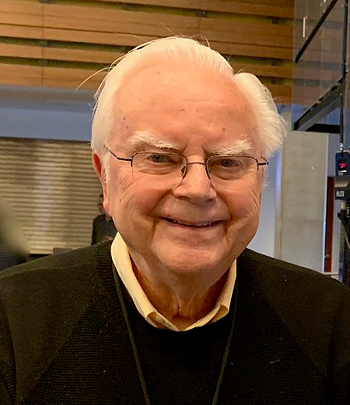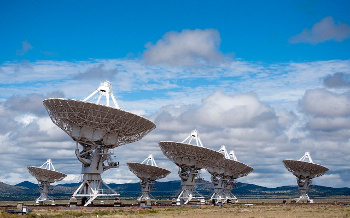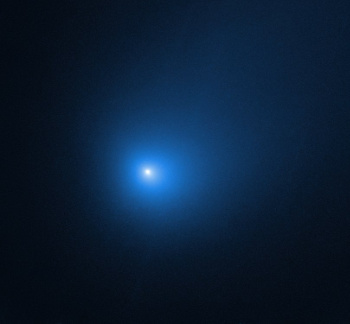SETI
April 6, 2020
There's a
joke about the
search for extraterrestrial intelligence (SETI) - We shouldn't waste time looking for it until we see some sign of
intelligent life on
Earth. One problem faced by SETI
researchers is the lack of
government funding. SETI has received no government funding in the
United States since 1993. One possible reason for this is that some
religious groups are threatened by the
idea that the
genesis of life on Earth was not a special event. Another problem is that the SETI concept itself is a
matter of faith.
The faith part of SETI is codified in the much criticized
Drake equation that
estimates the probability of the occurrence of a detectable extraterrestrial intelligence. Encoded in this equation is the idea that small numbers for such factors as the
fraction of
stars that have
planets, the fraction of planets on which
life arises, and the fraction that choose to
communicate their existence, are balanced by the large number of stars in our
galaxy. The number of stars in our
Milky Way galaxy is estimated to be between 100 and 400 billion.

Frank Drake, April 11, 2019.
In 1960, Drake listened for intelligent radio signals for 150 hours from the two nearby stars, Tau Ceti and Epsilon Eridani, using a 26 meter radio telescope at the National Radio Astronomy Observatory, Green Bank, West Virginia.
He examined a small bandwidth around the "water hole," the 1.420 gigahertz (21 cm wavelength) emission line of interstellar hydrogen.
This frequency is thought to be an obvious place for communications when no standard communications frequencies are known, since hydrogen is the most abundant element in the universe. Hydrogen is also a component of water, which is essential to life on Earth.
(Portion of a Wikimedia Commons photo by Steve Jurvetson)
A major problem with a
radio approach to SETI is that an advanced civilization may have moved from radio to a more advanced communication
technology that's unknown to us. Radio has been known to
humans for less than 150 years, and its limitations have inspired other communication technologies, such as
lasers. Fifty years ago, the world communicated using radio. Today, the
Internet is enabled by light
signals in
fiberoptic cables. Our
descendants might one day compare their communication technology to radio in the same way that we compare radio to
smoke signals. There's also the idea that, like us, others might just be listening and not
transmitting. The
cost of transmission is
orders of magnitude greater than that of listening.
In the absence of government funding,
private donations, especially from the
largesse of some
wealthy individuals, have kept SETI alive.
Paul Allen (1953-2018), a founder of
Microsoft, donated millions of dollars to the establishment of the
Allen Telescope Array at the
Hat Creek Radio Observatory of the
SETI Institute (Mountain View, California). I wrote about the Allen Telescope Array in an
earlier article (Allen Telescope Array, April 26, 2011).
Russian
physicist and
entrepreneur,
Yuri Milner, has donated $100 million for the
Breakthrough Listen initiative that includes an
optical SETI component. This initiative buys time on existing
radio telescopes in its SETI search. There's a
website for Breakthrough Listen at the
Berkeley SETI Research Center.

The Very Large Array (VLA), a portion of which is shown, was completed in 1980.
The dish antennas are mounted on railroad tracks in a "Y" pattern to adjust placement for interferometry at different wavelengths.
(Wikimedia Commons photo by CGP Grey. Click for larger image.)
The
Very Large Array (VLA), a component of the
National Radio Astronomy Observatory (NRAO), is an impressive assemblage of twenty-eight 25-meter
dish antennas on a
desert plain near
Socorro, New Mexico. Shortly after its completion, it was used in a
scene of the 1984 film, "
2010: The Year We Make Contact," the
sequel to the film, "
2001: A Space Odyssey."
The SETI Institute and NRAO have recently announced a collaboration to use the VLA for SETI research.[1-3] A new system called the Commensal Open-Source Multimode Interferometer Cluster Search for Extraterrestrial Intelligence (COSMIC SETI) will allow the VLA to continually look for SETI signals.[1-3] COSMIC will take
data from each VLA antenna from the same
data stream used for other VLA research and stream it through a parallel
ethernet interface to provide much more SETI data than obtained earlier.[1-2] Says
Tony Beasley,
Director of the NRAO,
"Determining whether we are alone in the universe as technologically capable life is among the most compelling questions in science, and NRAO telescopes can play a major role in answering it."[1]
The data from the COSMIC ethernet interface will be
analyzed by
signal processing software in a search for
technosignatures, the incidental
electromagnetic emissions of a technologically advanced, extraterrestrial civilization.[1] This SETI research will be conducted in parallel with
VLA's 5-year Sky Survey, which will survey 75% of the
entire sky, everything that can possibly be viewed from the VLA location.[1] The development of the COSMIC interface was funded by a
gift from
John Giannandrea, a
Trustee of the SETI Institute, and his
spouse, Carol.[1-2] As typical, no government money is involved.[1]
Beasley, speaking at the
2020 American Association for the Advancement of Science (AAAS) meeting (Seattle, Washington, February 13-16), said that it's "time for Seti to come in from the cold and be properly integrated to all other areas of
astronomy".[3] It's estimated that the COSMIC initiative will increase the chances of finding intelligent life by one, or two, orders of magnitude.[3] The
UK's Astronomer Royal,
Sir Martin Rees, noting that a SETI research expenditure is minuscule compared with "
Big Science" projects, is quoted by the
BBC in saying,
"I'd feel far more confident arguing the case for Seti than for a particle accelerator... Seti searches are surely worthwhile, despite the heavy odds against success, because the stakes are so high".[3]
In other SETI news from the AAAS meeting, the Breakthrough Listen Initiative released nearly 2
petabytes of data on February 14, 2020, from an extensive search for cosmic radio emissions from the Milky Way.[4] A previous data release of a petabyte of radio telescope and
optical telescope data was released in June, 2019.[4] About half of the radio data cover wavelengths from 1-12
gigahertz collected from the
Parkes radio telescope in
Parkes, New South Wales, Australia.[4] The Parkes location is able to observe the entire
galactic disk and
galactic center.[4] The other half was from NRAO's
Green Bank Observatory in
Green Bank, West Virginia.[4] Breakthrough Listen also released observations of the
interstellar comet 2I/Borisov.[4]

A photograph of interstellar comet 2I/Borisov at perihelion, December 12, 2019
The comet was 298 million kilometers from Earth in this photo. Comet 2I/Borisov was only the second interstellar object detected in our Solar System.
(Image by NASA, ESA, and D. Jewitt (UCLA) via Wikimedia Commons.)
One search, lead by
Sofia Sheikh of
Penn State University, looked for radio emissions from twenty nearby stars that are aligned with Earth's
orbital plane.[5] Any extraterrestrials on planets around those stars would know of Earth's existence, since they could see Earth pass in front of the
Sun using their telescopes.[5] The search was done using NRAO's Green Bank Telescope in West Virginia operating at billions of frequencies between 4 and 8 gigahertz.[4-5]
The data collection
strategy involved looking for radio emission from each star for five minutes, collecting signals away for five minutes, and repeating this pairing twice again.[4] There were several hundred
positives from this search, but all these were Earth-based or
satellite-based human
interference.[4] As Sheikh explains,
"If other civilizations have telescopes like ours, they would know that the Solar System has planets from their transits, and even know that Earth has life. That is how we have discovered thousands of other exoplanets, so it kind of makes sense to extrapolate and say that that might be how other intelligent species find planets as well. And if they know we're here, they might be signaling us.[5] My search was sensitive enough to see a transmitter basically the same as the strongest transmitters we have on Earth, because the targets were nearby... So we know that there isn't anything as strong as our strongest radars beaming something at us."[4-5]
One new SETI concept is the idea of galactic centers being so-called
Schelling points; that is, an obvious place to look when you don't know where to look.[6] The first such Schelling point was the previously mentioned hydrogen emission line. The galactic center is certainly the most interesting part of the Milky Way galaxy. A
radio beacon placed there could be
powered by its central four million
solar mass black hole.[4-6]
References:
- SETI Institute and National Radio Astronomy Observatory Team Up for SETI Science at the Very Large Array, SETI Institute Press Release, February 13, 2020.
- NRAO, SETI Institute Agree on New Research Programs, NRAO Press Release, February 15, 2020.
- Pallab Ghosh, "Astronomers want public funds for intelligent life search," BBC News, February 15, 2020.
- Robert Sanders, "Breakthrough Listen scans Milky Way Galaxy for beacons of civilization," University of California Berkeley Press Release, February 14, 2020.
- Looking for aliens who might be looking for us, Penn State University Press Release, February 14, 2020,
- Sarah Knapton, "Aliens might have placed beacon in centre of Milky Way, say scientists," Telegraph (UK), February 14, 2020.
Linked Keywords: Joke; search for extraterrestrial intelligence; SETI; intelligent life; Earth; research; researcher; government; funding of science; United States; religion; religious group; idea; abiogenesis; genesis of life on Earth; belief; matter of faith; Drake equation; probability theory; probability estimate; fraction(mathematics); star; planet; communication; communicate; galaxy; Milky Way; Frank Drake; Project Ozma; listened for intelligent radio signals; Tau Ceti; Epsilon Eridani; meter<; radio telescope; National Radio Astronomy Observatory; Green Bank, West Virginia; bandwidth (signal processing); waterhole (radio); gigahertz; centimeter; cm; wavelength; hydrogen line; emission line of interstellar hydrogen; frequency; communication; universe; water; life on Earth; Steve Jurvetson; radio; technology; human; laser; Internet; signal; optical fiber cable; fiberoptic cable; kinship; descendant; smoke signal; transmission (telecommunications); cost; order of magnitude; foundation (nonprofit); private donation; largesse; wealth; wealthy; Paul Allen (1953-2018); Microsoft; Allen Telescope Array; Hat Creek Radio Observatory; SETI Institute (Mountain View, California); physicist; entrepreneur; Yuri Milner; Breakthrough Listen; optical SETI; website; Berkeley SETI Research Center; Very Large Array (VLA); parabolic antenna; dish antenna; rrack (rail transport); railroad track; pattern; interferometry; Wikimedia Commons; National Radio Astronomy Observatory; desert; plain; Socorro, New Mexico; scene (film); 2010: The Year We Make Contact; sequel; 2001: A Space Odyssey; data; data stream; ethernet; interface (computing); Tony Beasley; director; science; analysis; analyze; signal processing; computer software; technosignature; electromagnetic radiation; electromagnetic emission; VLA Sky Survey; celestial sphere; entire sky; gift; John Giannandrea; trustee; spouse; 2020 American Association for the Advancement of Science (AAAS) meeting (Seattle, Washington, February 13-16); astronomy; United Kingdom; UK; Astronomer Royal; Sir Martin Rees; Big Science; BBC; particle accelerator; odds; petabyte; optical telescope; gigahertz; Parkes radio telescope; Parkes, New South Wales, Australia; galactic disk; galactic center; Green Bank Observatory; Green Bank, West Virginia; interstellar comet; 2I/Borisov; astrophotography; photograph; perihelion; kilometer; Solar System; NASA; European Space Agency; ESA; D. Jewitt (UCLA); Sofia Sheikh; Pennsylvania State University; Penn State University; orbital plane; Sun; strategy; statistical hypothesis testing; positive; satellite; electromagnetic interference; extraterrestrial life; other civilizations; transit (astronomy); exoplanet; extrapolation; extrapolate; sensitivity (electronics); radar; beam; beaming; focal point (game theory); Schelling points; radio beacon; power (physics); solar mass; black hole.